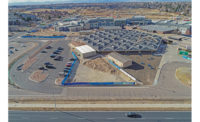The $54-million College Avenue Commons project on the campus of Arizona State University is in many respects a typical university project. The 130,000-sq-ft steel building, located on College Avenue between 6th and 7th streets in Tempe, connects the city and the university. It has a bookstore and a team shop and provides students with a place to meet and serves as a venue for hosting community meetings.
But what is unusual is that the building also happens to be a giant teaching tool for students at the university's Del E. Webb School of Construction, housed in the building. The construction manager at-risk project, built by Okland Construction and designed by Gensler|Architekton, gives students a chance to see how buildings work—from the inside out.
"I would almost call this choreography: the way these systems were designed and presented so they are recognizable," says Jay Silverberg, principal, Gensler. "One can see how buildings are built. That's why it is different than other exposed styles."
The first floor was designed to be the welcome mat for the university, where the city of Tempe and ASU meet at the north edge of campus. It is where most new freshman will arrive to begin their education and take campus tours. But the lower levels are not just an accumulation of classrooms, a student center, a community meeting place or a fitness center, they are all of those things simultaneously.
"It is a whole new college commons experience," says Tom Reilly, director, Architekton.
The bookstore will sell little beyond supplies and university apparel, while food service areas and other retail spaces will occupy most of the first two levels. ASU functions will occupy the remainder of the building.
The Building As A Tool
The upper levels, however, contain the construction teaching elements that make the project unique, the designers of the building say.
The Del E. Webb School of Construction, located on the third and fourth floors, is a training ground for scores of project managers and other construction professionals across the Southwest. The building itself serves as one of their first educational tools.








Post a comment to this article
Report Abusive Comment